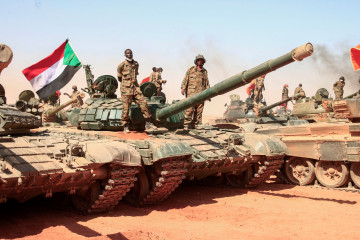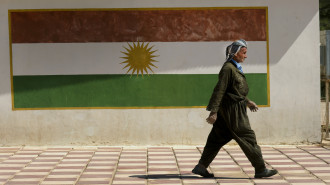

Sudan’s war, which began in the capital Khartoum, has now spread to 10 of Sudan’s 18 states, with the Rapid Support Forces (RSF) overrunning Sudanese army garrisons in eight state capitals.
The RSF is also currently laying siege to El Fasher in North Darfur, marking an attempt to capture the army’s final stronghold in the country’s western region of Darfur. This escalation has garnered significant international condemnation.
The recent seizure of El-Fula, the capital of West Kordofan state, and most of Sennar state by the RSF has also revived fears that they could capture the whole country.
Calls for the resignation of SAF leader, General Abdel Fattah al-Burhan, were widespread after the RSF took Wad Madani. The city had been regarded as a safe haven for individuals displaced by the conflict in Khartoum until the RSF arrived in December.
Demands for al-Burhan to step down have intensified as the RSF continues to expand and war threatens the remaining conflict-free regions of Sudan.
However, a change in leadership alone might not be enough to save Sudan’s army. According to El-Tigani Ibrahim, a former Minister of State for Finance and Economy, the issues plaguing it are structural.
“The army was structured to protect the regime rather than the state,” Ibrahim told The New Arab.
Ibrahim held the position of minister under the cabinet of the late El-Sadig El-Mahdi, Sudan's last elected prime minister. El-Mahdi’s government was overthrown by Omar al-Bashir, who ruled Sudan from 1989 until he was removed from power following nationwide protests in 2019.
After successfully staging a coup, al-Bashir initiated a process known as ‘tamkeen’ (empowerment), which facilitated the rise of Islamist-aligned officers within the Sudanese Armed Forces (SAF). This process also resulted in the removal of officers perceived as opposing the new regime.
In addition to becoming a more politicised force, the military became increasingly immersed in business, with the rise of companies linked to the military and its top brass. These companies functioned without state oversight and came to control large sections of the economy over the last three decades.
“Those [in the military] with the rank of Colonel and up were the primary beneficiaries [of corruption] - the army didn’t spend much money on foot soldiers and their fighting ability,” Ibrahim added.
Decades of underinvestment in the army's capabilities allowed the RSF to grow and become the security sector's de facto infantry. Al-Bashir formalised the RSF by decree in 2013 and by the time of the current war, its forces had grown to nearly parallel the size of Sudan’s military.
Even before the war, the RSF was considered more capable of fighting insurgencies in Darfur and in controlling the streets of Khartoum, after mass protests against al-Bashir’s rule erupted in 2018. RSF soldiers also formed the bulk of the Sudanese forces deployed as part of the Saudi-led coalition at war with the Houthi rebels in Yemen.
The SAF’s vulnerabilities became apparent early in the war when it leaned into mass conscription in hopes of containing the RSF.
The ‘popular resistance’, as it is known, was well received by the public with tens of thousands of recruits signing up to join, but to many, it was a sign that the army was in a weak position vis-à-vis the renegade paramilitary it’s currently fighting.
Furthermore, the efficacy of mobilising volunteer recruits to fight the RSF was quickly frustrated by logistical challenges and citizens have regularly aired complaints that the army is dragging its feet in organising the popular resistance and delivering arms to trainees who had completed training.
|
|
“There were very motivated recruits there [Sinja], but they did not do much because they were not armed. If they were armed, they would not have followed the army's orders to withdraw,” Hatim told The New Arab.
*Hatim, 22, recently fled the city of Sinja in Sennar State after the RSF attacked it. In his opinion, many of the SAF's losses are due to the fact that volunteer recruits, who are often the most eager to engage in combat, were not being properly armed.
In Sinja, the recruits that Hatim knew personally were “ready to die at any moment [fighting the RSF], because they are defending their hometown”, he said.
Given the low public confidence in the army and the heightened risk of potential atrocities by the RSF in frontline states, citizens have even appealed to Burhan directly to arm them as soon as possible.
In a recent video in Manaqil, the army's last stronghold in al-Jazira state, a man in the crowd can be heard telling al-Burhan that, “We don't need men from you, we need vehicles and heavy arms”.
"The army was structured to protect the regime rather than the state"
In addition to having better-equipped, better-trained, and more experienced fighters, the RSF has shown that it is growing stronger as it captures more territory. Doing so has allowed it to acquire vast stockpiles of weapons from the SAF’s fallen garrisons, and also control important border regions from which fighters and more arms can make their way into the hands of the RSF.
The RSF's offensive in Darfur, which enabled it to seize control of nearly the entire region in late October and early November of 2023, was facilitated by several factors, including “new military supply lines running through Chad, Libya, and South Sudan”, as reported by a UN Panel of Experts on Sudan.
A more recent UN Panel of Experts Report on the Central African Republic (CAR) also found that opposition groups in the CAR “sent members of their own groups to fight in Sudan under RSF”.
These advantages have been bolstered by the fact that the RSF seized the Yarmuk Munitions Complex, the largest weapon manufacturing facility in Sudan, which contained vast stockpiles of bombs, artillery, rifles, and armoured vehicles in June of last year.
The move deprived the SAF of much-needed firepower and pushed it to seek arms from external partners, namely, Russia and Iran.
After over a year of war, however, the SAF has given little indication that it can correct course before it’s too late.
“The SAF suffers from the inability to be more critical of itself,” Harry Verhoeven, a Senior Research Scholar at Columbia University and author of ‘Water, Civilisation and Power in Sudan: The Political Economy of Military-Islamist State Building’, told The New Arab.
“It's the RSF that's doing all the running, that's making moves and creating facts on the ground and the army since day one has been responding as opposed to taking the initiative, that's the simple truth,” Verhoeven added.
Despite the dire humanitarian crisis in Sudan, described by Edem Wosornu, Director of Operations and Advocacy at UNOCHA, as one of the “worst humanitarian disasters in recent memory,” the army's generals remain determined to continue fighting despite their weak position on the battlefield.
In a recent statement, Sudanese army assistant commander-in-chief, Yasir al-Atta, declared that “there will be no negotiation, no truce, even if the war lasts 100 years”.
Without hopes of a ceasefire or a change in strategy in sight, the current trajectory of the conflict could well lead to the SAF’s implosion, and with it, the total disintegration of the state.
Sudan’s displacement crisis, currently the worst in the world, has developed primarily due to the RSF’s expansion. As the RSF has expanded its reach, its forces have engaged in indiscriminate killing and the forced displacement of civilians, as well as looting markets, seeds, fertilisers, and agricultural equipment.
These actions have caused significant disruptions to critical food production, contributing to a projected famine that could claim the lives of 2.5 million Sudanese by September of this year.
Since this dire prediction was made in a report published by the Clingendael Institute in May, the RSF has expanded into more of Sudan’s fertile regions, further exacerbating the scale of the crisis.
“It's a very difficult situation because the SAF has a lot of problems, but in a way, you have to hope that they win because the alternative scenario is even worse,” Verhoeven said.
*Name changed at the request of interviewee
Elfadil Ibrahim is a writer and analyst focused on Sudanese politics




 Follow the Middle East's top stories in English at The New Arab on Google News
Follow the Middle East's top stories in English at The New Arab on Google News


